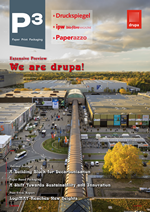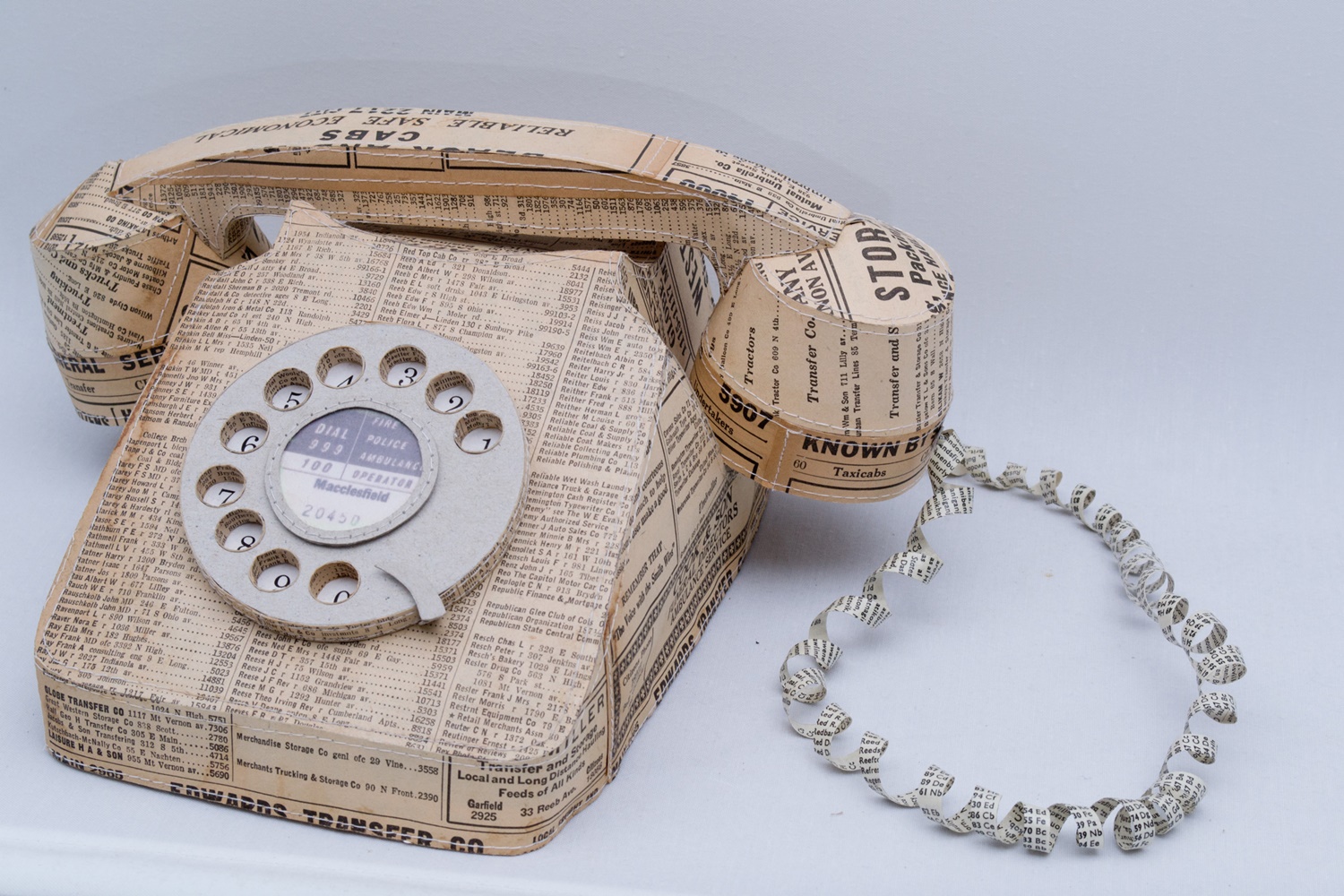P3 3-4/2022 en
Sewing, Gin & Tonic
“Integrity is the Most Important Thing!”
Paper & People
Paper pioneer Jennifer Collier creates exquisite sculptures from vintage recycled materials in conjunction with stitch; a contemporary twist on traditional textiles. The papers serve as both the inspiration and the media for the work, with the narrative suggesting the forms. Through this marriage of unlikely materials old papers are transformed into something truly unique, delicate and complex. P3 / Paperazzo took a lot of her time for a detailed conversation – here’s the director’s cut!
Just make the call: Paper telephone made by Jennifer Collier.
Jennifer, let’s start by giving our readers a first impression: What motivation and which defining events brought you to the spot in life and work where you are now? And what was the key for you in deciding to devote yourself to exactly this type of work?
My degree course (BA Hons Textiles) was geared towards preparing it students for industry, but I realised fairly early on this wasn’t what I wanted to do, and that I wanted to make every piece with my own hands. So when I graduated I applied for residencies and my first one was at a gallery. This threw me into making and selling my own work and undertaking art workshops, which was perfect at this transitional stage in my career. The next residency I did was at the Museum of Science and Industry in Manchester as part of the North West Arts Boards “Setting Up Scheme”. This gave me a free studio, as well as a maintenance and equipment grants, so I had money and time to set up by business when I was starting out.
What does your daily workspace look like? Is it tidy or rather mixed-up?
I work from my own contemporary craft gallery, artist studios and workshops space, Unit Twelve. Established in May 2010 as an artist led space, we have developed a year round programme of high quality contemporary craft exhibitions and workshops, as well as providing studio space to 5 artists. We also offer a learning experience in an informal environment with the country's best makers, which attracts repeat visitors locally, nationally and even internationally. As Unit Twelve is open to the public (Thursday-Saturday, 10-4pm) I do have to work tidily – on the days we are not open I tend to spread out and work on bigger pieces or commissions, but make sure on days that we are open to the public that the space looks presentable, even if this is the organized chaos of a working studio.
Can you describe what the path from an idea to the completion of a new piece looks like?
My practice focuses on creating work from paper; I produce paper “fabrics”, which are used to explore the “remaking” of household objects. The papers are treated as if cloth, with the main technique employed being stitch; a contemporary twist on traditional textiles. The papers themselves serve as both the inspiration and the media for my work, with the narrative of the books and papers suggesting the forms, for example a sewing machine made from dress making patterns, or a camera out of vintage photographs. My way of working is essentially still based on the processes of my past work and my textiles training – making a pattern, producing a toile to check the pattern or template “works” and then creating the “real” piece of work from beautiful found and recycled papers. In layman’s terms it is a bit like then you draw the net of a box from scratch, cut it out, fold and construct it; but mine are much more complicated shapes …
I honestly believe the best way to learn is by not being afraid to make mistakes.
Jennifer Collier, contemporary craft maker.
Do you always get the desired result or are there also outcomes that leave you unsatisfied?
No, but I honestly believe the best way to learn is by not being afraid to make mistakes, this way you allow yourself to have happy accidents. All of the techniques I use in my work now are things I have taught myself since graduating by experimenting with different media and techniques. Probably more than half of my work never sees the light of day, but through the other half I have discovered something truly unique.
Do you use material other than paper, i.e. leather or fabrics?
No, all of my work is paper. I originally trained in textiles completing a BA (hons) Textiles, at Manchester Metropolitan University, in 1999. This was a traditional textiles course specialising in Print, Knit and Weave. Toward the end of the course I started experimenting with different materials, weaving with orange peel, melting fruit bags; all manner of things my tutors did not approve of. I spent many years trying to emulate the qualities of paper, and suddenly it just made sense to use it as the media and the inspiration for my work.
Have you ever thought about designing clothing for puppets, i.e. for a children’s theater?
No – I have always felt strongly that I want my work to be considered art textiles rather than fashion, and find it more interested in seeing it with the absence of the body.
It appears you have a lot of garden objects in your collection. Do you like gardening?
I love it. It is always hard when your enjoyable pastime becomes your job, so sewing has become work to me, so gardening has ended up become my enjoyable pastime instead. Saying that there is nothing I love more that a bit of hand sewing in the garden with a little Gin and Tonic …
What is the aim behind your work (except for, probably, getting a few quid)? Without wanting to sound unnecessarily pathetic: Do you want to convey meaning?
To save these beautiful old papers that would otherwise get thrown away, and be unloved and take time to play with different techniques in order to breathe new life into the item. I often have some things for years before I think what to do with it, or am “brave” enough to use it, as I don't want to waste it … I enjoy nothing more than finding a cook book splattered with food stains or a water damaged paperback that no one else would want that I can save from land fill and transform into something beautiful.
In your opinion, what is more important if you want to be successful with art these days: talent and inspiration, a sound education, or being in the right place at the right time?
I believe everything you do is a stepping stone to the next thing you will do, so the more important thing is to be determined – if people say no, keep asking till they start saying yes.
I believe integrity is the most important thing when making work commercially.
Jennifer Collier, contemporary craft maker.
Are you necessarily an idealist as an artist or do you have to be able to afford such an attitude when facing open bills? In your opinion, how fine is the line between art and commerce when you depend on the income?
I believe integrity is the most important thing when making work commercially. I have always run art workshops as an income stream so that I have never been forced to make work that I don’t utterly adore. My work is not everyone’s taste, but I would prefer 10% of the people to love it, than making mass produced work without integrity that everyone wants.
It may sound silly at this point, but did music (in general or a certain style) have an influence on your work?
Not particularly – I am not able to work in silence, so I tend to have the radio on when I am working, and sing along if it is a song I particularly love.
Are there other forms of artistic expression that you feel could appeal to you in the future?
I have no idea, but I am always open to experimenting and playing to push my practice further.
It is everyone’s jobs to point out the disgraces of the world.
Jennifer Collier, contemporary craft maker.
The question currently has a certain explosiveness: In your opinion, are today’s artists obliged to make political and social statements to point out the disgraces of the world? What are your feelings regarding the Ukrainian war?
I consider myself to be a contemporary craft maker rather than an artist, and as such my emphasis is on creating beautifully crafted paper sculptures, rather than fine art. Though I choose not to voice my opinions though the work that I make, I do feel it is everyone’s jobs to point out the disgraces of the world, thought conversations with friends, interactions with other and through social media. As my husband is also a maker, we have been raising money for Ukraine as a family by auctioning art work.
Can you be commissioned with a specific job, and if so, what would an interested party have to do for it?
Just get in touch! I sell through the beautiful madebyhandonline.com, where people can directly commission items from my range. But I do also make site specific work, often for heritage site or public art commissions too.
Last question: How do you preferably spend your spare time?
With a gin and tonic, sewing in the garden – see above!
Jennifer, thank you very much for the conversation.
(Editor's note for our readers: For further information, we would like to refer you to http://www.jennifercollier.co.uk/ and in particular to the FAQs listed there.)

Jennifer Collier creates exquisite sculptures from vintage recycled materials in conjunction with stitch.
Editor: sbr
Images: Jennifer Collier

















